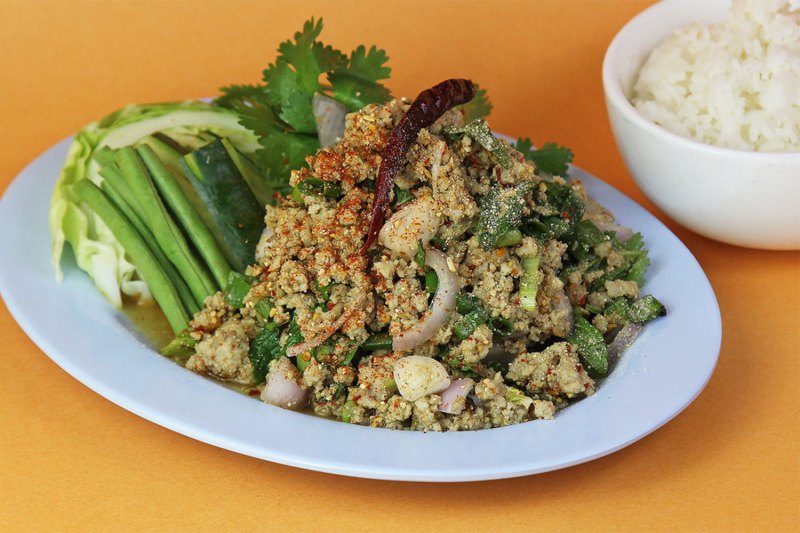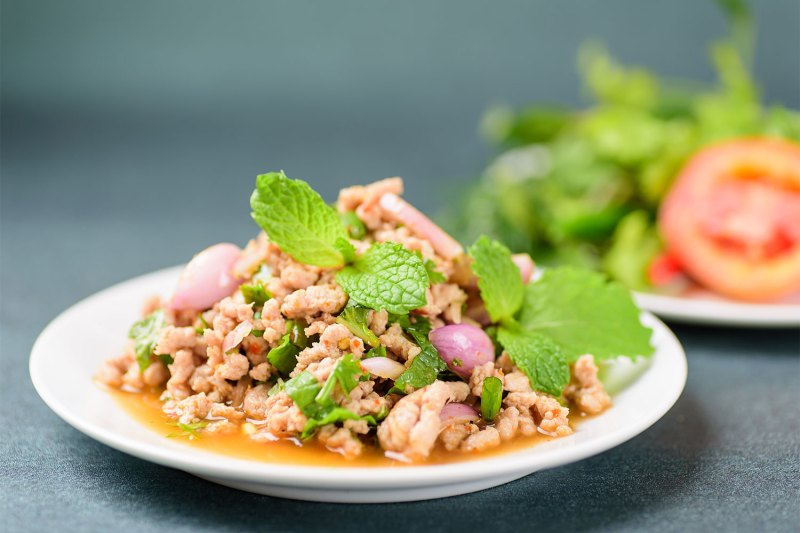In many parts of the country, warm and sunny summer weather is taking its sweet time to reappear on a consistent basis … which, considering the current circumstances, feels a bit like adding insult to injury. But sooner or later, balmy days and mild nights will become a regular state of affairs, and we’ll need to start adjusting our at-home kitchen repertoires to reflect that seasonal change. Hearty soups, rich pastas, and roasted meats may give way to fresh, lightweight entrees that incorporate plenty of herbs, bright acid, and vivid spice, and a dish that maximizes on all of these flavors while also providing plenty of protein can be found in the Southeast Asian salad known as larb.
What is Larb?
Larb, commonly referred to as larb gai (chicken larb) or larb moo (pork larb), is a salad that originates in the nation of Laos. The dish has a major presence in the Isan region of Northern Thailand as well, thanks to a sizable Laotian immigrant population in the area. Traditionally, larb consists of minced or ground meat, lime juice, fish sauce, chili, herbs like mint and cilantro, and a powder made from ground toasted rice, which serves to bolster both the flavor and the texture of the dish.

Chef Chai Chaowasaree, who specializes in Thai cuisine at his hit Honolulu restaurants, says that “[larb] has a wonderful variety of flavors – acidity from the lime juice, saltiness from the fish sauce, and heat from the dried chili pepper flakes. The fresh mint leaves, cilantro, and green onions bring out the brightness of the dish.” He also notes that “the most important ingredient in this dish – the one that makes it distinctive in both flavor and texture – is toasted rice powder. If you cannot find it, you can easily make it at home by putting raw sticky rice into a 350-degree-Fahrenheit oven for about fifteen minutes or so, until it is deep golden brown. Then grind it into a powder in a food processor or spice or coffee grinder.”
Which Proteins are Used for Larb?
While larb often utilizes ground pork or chicken, chefs have plenty of liberty to try different proteins in this dish. You can find everything from fish and shrimp larb to tofu larb at restaurants throughout the U.S., and if you’re more drawn to red meat, then ground lamb adds an appealingly savory dimension to the dish. At least, that’s what chef Nick Bognar of Indo in St. Louis believes, insisting that “the strong spice flavors and funkiness of the seasoning we use melds well with the gaminess of lamb. Lamb can be a stronger taste to some, but when balanced well with [other] flavors, it has immense umami potential.”
How Should Larb be Served?
When it comes to traditional styles of larb service, chef/owner Shayn Prapaisilp of Chao Baan in St. Louis tells us that “my family grew up eating larb with sticky rice in typical northeastern [Thai] fashion, so that is my personal favorite. The northeast of Thailand borders Laos, where sticky rice is the main carb. A lot of dishes work around sticky rice as the main accompaniment, and when I’m craving something that screams ‘home’, it’s sticky rice and larb.”
Culinary blogger ChihYu Smith of I Heart Umami also favors sticky rice with larb, and she offers the following instructions to home cooks: “Use your hand to grab a small amount of sticky rice and gently press the rice with your fingers to form a small indent. Take one bite of larb with herbs, then dip the rice in the juice on the plate to soak up all the delicious salty and citrus flavor. The dish tastes smoky, salty, sour, and a little spicy. It’s absolutely delicious. “

If you’d prefer a lower-carb way to enjoy larb, then executive chef Jutamas “Kwan” Kanjanamai of Noi Thai Cuisine in Honolulu suggests putting “hot larb in lettuce cups, with vegetable sides [like] cold cucumber and cabbage and a mint garnish.” Very leafy lettuces like Bibb and butter lettuce tend to work best as larb cups.
Ready for a DIY larb experience? Try this recipe bursting with spice, citrus, and acid:
Larb Moo
(By Ohm Suansilphong, chef/owner, Fish Cheeks, New York City)
Chef Ohm considers himself an equal larb-protein opportunist, claiming that “I would cook larb with either chicken, pork, beef, or fish. I do believe all proteins go really well with the combined flavors of the seasonings.” For his staple larb recipe, however, he uses ground pork, which he serves alongside fresh seasonal vegetables and sticky rice.
Ingredients:
- 1 lb minced pork
- .5 cup stock or water
- 2-3 makrut lime leaves
- 1 tbsp toasted sticky rice ground into a powder
- .5 shallot, sliced into .5-inch pieces
- A few leaves of saw leaf- aka “culantro” or “Mexican coriander” (depending on taste), chopped into .5-inch pieces)
- A few scallions (depending on taste), chopped into ½ -inch pieces
- 1 sprig of mint
- 2 tbsp fish sauce
- 2 tsp chili powder
- The juice of 2 limes
- 2 dried chilies (optional)
Method:
- Add minced pork and stock to a pot and cook over medium-high heat.
- Once the pork is fully cooked through, tear up the makrut leaves and add to the pot, then turn off the heat.
- Add fish sauce, chili powder, lime juice, and remaining ingredients to the pot. Mix everything in the pot to combine.
- Plate with fresh raw vegetables (Chef Ohm advises cucumbers, long beans, and cabbage) and sticky rice.
Editors' Recommendations
- All Soup For You: 8 Refreshing Chilled Soups To Add To Your Summer Menu
- Pisco Cocktails are the Refreshing Balm You Need for the Dog Days of Summer


